Kenta Furukawa, Qiyan Wang, Masakazu Yamashita
Department of Environmental Systems Science, Doshisha University, 1-3 Miyakodani, Tatara, Kyo-tanabe, Kyoto 610-0394, Japan
Correspondence to: Masakazu Yamashita, Department of Environmental Systems Science, Doshisha University, 1-3 Miyakodani, Tatara, Kyo-tanabe, Kyoto 610-0394, Japan.
| Email: |  |
Copyright © 2014 Scientific & Academic Publishing. All Rights Reserved.
Abstract
In recent years, hybrid automobiles have become increasingly popular for reasons including the increase in fuel efficiency. The present study compared the costs of driving gasoline-fueled and hybrid automobiles to examine whether or not the future introduction of hybrid automobiles will be effective. The results suggest that hybrid automobiles are the first-choice next-generation cars. However, the results also suggest that the introduction of the hybrid system to automobiles with an engine of 1.5 L or smaller is ineffective. Furthermore, a relationship was noted between the price of a hybrid automobile, which is relatively expensive, and its fuel efficiency or driving distance, and the higher the fuel efficiency, or the longer the driving distance, the greater the cost efficiency. The present study suggests that there is no point in adopting the hybrid system for small automobiles. Therefore, gasoline-fueled automobiles will continue to be widely used, and sales of hybrid automobiles are not expected to exceed those of gasoline-fueled ones.
Keywords:
Comparison, Hybrid car, Gasoline-fueled car, Cost efficiency
Cite this paper: Kenta Furukawa, Qiyan Wang, Masakazu Yamashita, Assessment of the Introduction of Commercially Available Hybrid Automobiles - Comparison of the Costs of Driving Gasoline-fueled and Hybrid Automobiles -, Resources and Environment, Vol. 4 No. 4, 2014, pp. 200-208. doi: 10.5923/j.re.20140404.03.
1. Introduction
People have become increasingly interested in CO2 emissions due to the issue of global warming. The amount of CO2 emissions related to the transport industry accounts for approximately 18% of the total, 87% of which is related to automobiles [1]. Since hybrid automobiles only require electricity to drive at a low speed, their total gasoline consumption can be reduced. This means that the hybrid system increases the fuel efficiency and reduces fuel costs, which may contribute to the reduction of CO2 emissions [2]. However, the prices of hybrid automobiles are still higher than those of gasoline-fueled ones, and they are not widely used. In this context, the present study compared the costs of driving gasoline-fueled and hybrid automobiles to examine whether or not the adoption of hybrid automobiles provides benefits for consumers.The present study compared the fuel costs required to drive different automobiles based on their prices and lifetime running distances, while taking into consideration the patterns of the use of automobiles by consumers and performance of automobiles. The study also examined the relationship between gasoline-fueled and hybrid automobiles from an economic viewpoint to identify the optimal selection method in the future.
2. Comparison of the Costs of Driving Similar Types of Automobile
2.1. Fit and Fit Hybrid
A comparison of two similar types of automobile manufactured by Honda: Fit and Fit Hybrid, was conducted. Since the total engine capacity of Fit is 1.3 L, it is classified as a small automobile (the number on the car registration plate starts with 5) [3]. The fuel efficiencies of the lowest-class Fit and Fit Hybrid in JC08 mode were 21.0 and 26.4 km/L, respectively. Table 1 shows their prices and other details, and Figure 1 shows a graph that represents the relationship between the fuel efficiency and price (the price of gasoline was set at 140 and 160 yen/L).| Table 1. Outline of Fit series [3] |
| | | Fuel efficiency in JC08 (km/L) | Price (yen) | Weight of automobile (kg) | | Fit | 21.0 | 1,230,000 | 990 | | Fit Hybrid | 26.4 | 1,590,000 | 1,140 |
|
|
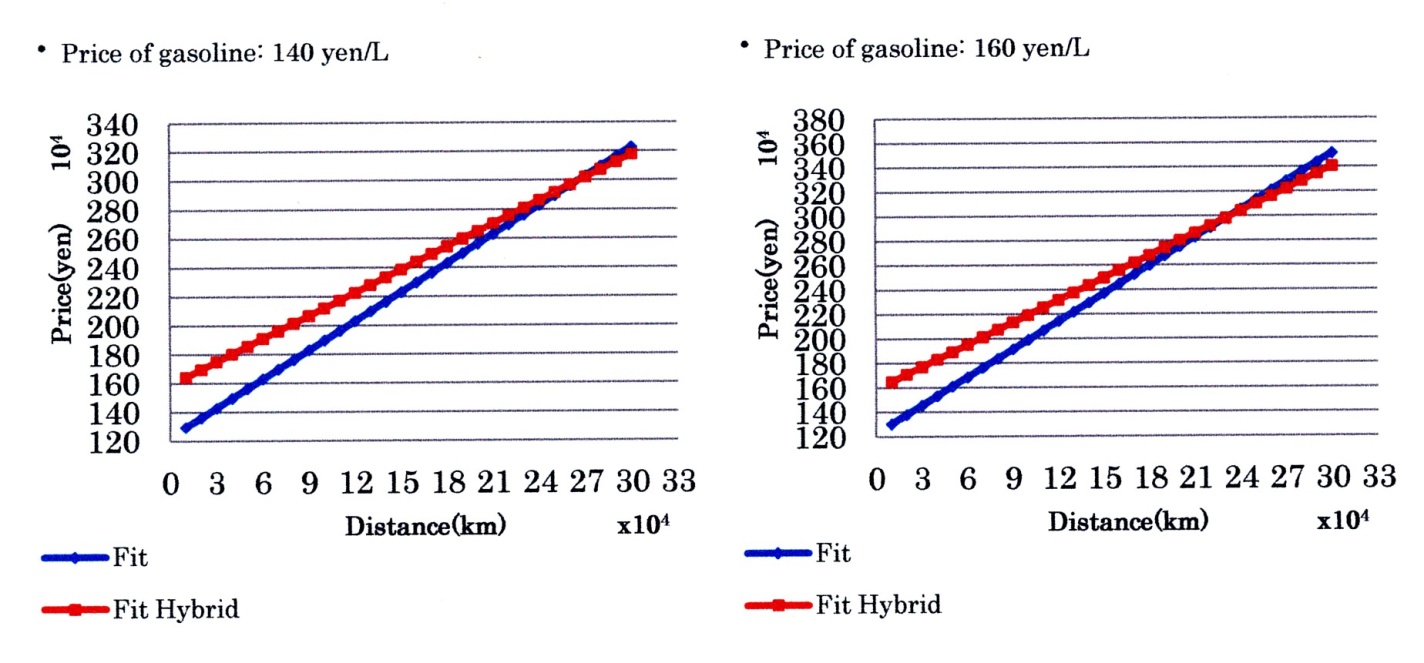 | Figure 1. Comparison of the costs of driving Fit and Fit Hybrid of a class |
The comparison results suggest that Fit Hybrid is required to drive more than 200,000 km, when the price of gasoline is 160 yen/L, to compensate for the price difference between Fit and Fit Hybrid, and, therefore, there is no advantage of purchasing Fit Hybrid. Since small gasoline-fueled automobiles have adopted idling-stop and other functions to improve fuel efficiency in recent years, it is difficult for hybrid automobiles of similar grades to compensate for the price differences, as shown in the above-mentioned figure.
2.2. Crown and Crown Hybrid
Following this, two automobiles with a large engine capacity of 2.5 L, Toyota Crown and Crown Hybrid, were compared.The total engine capacity of Crown is 2.5 L, which is almost twice as large as that of Fit, and it is classified as a standard-sized automobile (the number on the car registration plate starts with 3) [4]. The lowest-class Crown and Crown Hybrid were compared, as in the comparison of Fit and Fit Hybrid. The fuel efficiencies of the lowest-class Crown and Crown Hybrid in JC08 mode were 11.4 and 23.2 km/L, respectively. The fuel efficiency of the hybrid automobile is almost twice as high as that of the gasoline-fueled one. Table 2 presents outlines of the two automobiles.| Table 2. Outline of Crown series [4] |
| | | Fuel efficiency in JC08 (km/L) | Price (yen) | Weight of automobile (kg) | | Crown | 11.4 | 3,570,000 | 1,550 | | Crown Hybrid | 23.2 | 4,100,000 | 1,640 |
|
|
Crown Hybrid is 90-kg heavier than Crown, being significantly smaller than the difference between the weights of Fit and Fit Hybrid. However, the fuel efficiency of Crown Hybrid is almost twice as high as that of Crown. On the other hand, the fuel efficiency of Fit Hybrid is 1.25 times higher than that of Fit, although the weight difference is 150 kg. Figure 2 shows graphs representing the relationships between the fuel efficiencies of different automobiles and their prices, created in the same manner as Figure 1. | Figure 2. Comparison of the costs of driving Crown and Crown Hybrid of a class |
The comparison results suggest that the price difference can be compensated for if the running distance is more than approximately 90,000 and 80,000 km when the price of gasoline is 140 and 160 yen/L, respectively. The running distance required for the compensation is close to the lifetime running distance, which suggests that, the larger the engine capacity or weight of the automobile, the more effective the adoption of the hybrid system.
2.3. Camry and Camry Hybrid in the U.S.A.
A comparison of automobiles of the same class used in the U.S.A., Toyota Camry, was also conducted. Camry is also produced and sold in Japan. The present study selected the series of automobiles for the following reasons:1. Since only the Hybrid Camry lineup is sold in Japan, the comparison of hybrid and non-hybrid automobiles of the same model for detailed examinations cannot be implemented.2. The method for the measurement of the fuel efficiency implemented in Japan is different from that adopted in the U.S.A. In Japan, fuel efficiencies are measured in the 10/15 and JC08 modes. Fuel efficiencies measured in the U.S.A. in two modes, on general roads and highways, are accurate, and represent the fuel efficiency during actual driving.3. There is a difference in the price of gasoline between Japan and the U.S.A.The mean price of gasoline in the U.S.A. is 3.3 dollars/gallon (as of February 2013) [5, 6], or approximately 80 yen per liter (L) when one dollar is 90 yen, which is significantly cheaper than in Japan.There are both hybrid and non-hybrid Camry models. The price of the standard model is 22,850 dollars (2,060,000 yen when one dollar is 90 yen) and that of Camry Hybrid is 26,785 dollars (2,410,000 yen when one dollar is 90 yen). The fuel efficiencies of Camry Hybrid and the standard model are 43 (18.3 km/L) and 25 (10.6 km/L) miles/gallon, respectively. In the U.S.A., fuel efficiencies are measured in two modes, on general roads and highways, and more accurately represent fuel efficiencies during actual driving, compared to the measurement conducted in Japan. Table 3 presents an outline of the Camry series [7].| Table 3. Outline of Camry series [7] |
| | | General roads (miles/gallon) | Highways (miles/gallon) | Price (dollars) | Weight of automobile (kg) | | Camry | 25 | 35 | 22,850 | 1,450 | | Camry Hybrid | 43 | 39 | 26,785 | 1,560 |
|
|
The higher the price of gasoline, the more effective the adoption of the hybrid system, although the introduction of hybrid automobiles to the American market is at an early stage. Figure 3 shows a comparison of the costs of driving hybrid and non-hybrid automobiles (one dollar = 90 yen).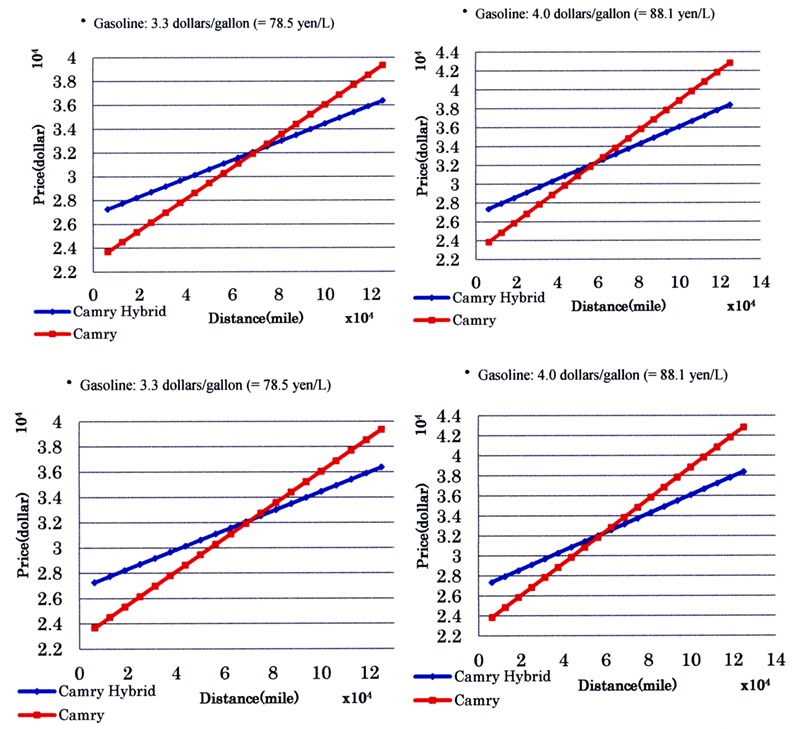 | Figure 3. Comparison of Camry and Camry Hybrid of a class |
The price difference can be compensated for if the hybrid automobile runs more than 110,000 and 100,000 km when the price of gasoline is 3.3 and 4.0 dollars/gallon, respectively. The price difference can also be compensated for if the hybrid automobile runs more than 90,000 km (on roads excluding highways) when the price of gasoline is 4.5 dollars/gallon, although this is not shown in the figure. The comparison results suggest that the introduction of Camry Hybrid is at an early stage.However, since highways are frequently used in the U.S.A., the actual fuel efficiency of the gasoline-fueled Camry may be higher than the fuel efficiency recorded during the simulation experiment, and the actual running distance may be longer.
3. Comparison of the Costs of Driving Prius, Aqua, and Gasoline-fueled Automobiles
The sales of Aqua and Prius, hybrid automobiles from Toyota, have been ranked in the top 3 in Japan. Although they are popular to some extent, there has been no sharp increase in the total number of hybrid automobiles [8]. The significance of the adoption of Prius and other hybrid automobiles was examined by comparing them with similar types of gasoline-fueled automobile because non-hybrid Prius and Aqua are unavailable.The engine capacities (1.8 L for Prius), weights, and dimensions of Toyota Prius and Allion, which is the most analogous to Prius, were compared. Table 4 shows the details [9, 10].Table 4. Outlines of Prius and Allion
 |
| |
|
Prius is heavy because the numbers of components and parts of a hybrid automobile are significantly larger than those of a gasoline-fueled automobile.The fuel efficiency of Prius in the 10/15 mode is 38.5 km/L, which is almost twice as high as that of Allion (18.6 km/L). A significant difference was also noted in the fuel efficiency in the JC08 between the two automobiles: 16.4 km/L for Allion and 32.6 km/L for Prius.The total engine capacity of Aqua is 1.5 L, which is smaller than that of Prius. In addition to this, Aqua is classified as a “small automobile” (the number on the car registration plate starts with 5). Although it was difficult to select an automobile that is analogous to Aqua for comparison, Toyota Vitz, with the same engine capacity, was chosen. Table 5 presents outlines of Aqua and Vitz [11, 12].Table 5. Outlines of Aqua and Vitz
 |
| |
|
Although there is no difference in the length of the body between Aqua and Vitz, the weight of Vitz is heavier and there is a difference in the power output. Therefore, it is difficult to consider a comparison of Aqua with Vitz as one between hybrid and non-hybrid automobiles of a model.First, the relationships between the fuel efficiencies and prices of Prius and Allion in the JC08 mode were examined. Figure 4 shows functions of the prices and distances when the price of gasoline was set at 140 and 160 yen.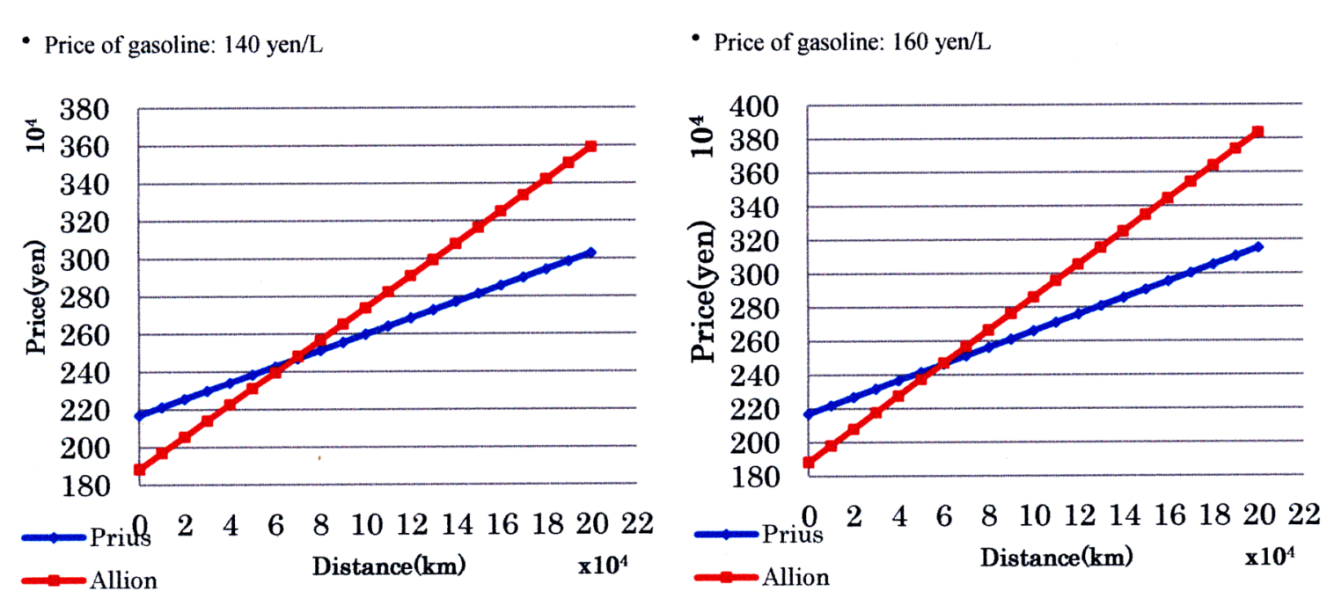 | Figure 4. Comparison of the costs of driving Prius and Allion |
The price difference can be compensated for if the running distance is more than approximately 80,000 and 70,000 km when the price of gasoline is 140 and 160 yen/L, respectively. This suggests that the introduction of the hybrid automobile is effective, considering the lifetime running distance.The fuel efficiencies (in the JC08 mode) and prices of Aqua and Vitz were compared. Figure 5 shows functions of the prices of Aqua and Vitz and running distances when the price of gasoline was set at 140 and 160 yen/L. | Figure 5. Comparison of the costs of driving Aqua and Vitz |
The price difference between Aqua and Vitz can be compensated for if the running distance is more than 50,000 and 40,000 km when the price of gasoline is 140 and 160 yen/L, respectively. This suggests that the introduction of the hybrid automobile is effective, considering the lifetime running distance.The actual fuel efficiencies of the two automobiles were also compared. As explained in the previous paper [13], the actual fuel efficiency represents the fuel efficiency during actual driving instead of one calculated in the 10/15 or JC08 mode - the measurement methods adopted in Japan. In the present study, correction factors were used to calculate the actual fuel efficiency [14, 15]. When the actual fuel efficiency of a hybrid automobile is expressed as faHV and fuel efficiency in the 10/15 is represented as fmHV, the following formula is assumed: faHV = 0.622 fmHV. Using this formula, the actual fuel efficiency of Prius is calculated as 22.1 km/L. When the actual fuel efficiency of a gasoline-fueled automobile is expressed as faV and fuel efficiency in the 10/15 is represented as fmV, another formula is assumed: faV = 0.760 fmV.Using this formula, the actual fuel efficiencies of Prius and Allion are calculated as follows: 38.5 × 0.622 = 23.9 km/L and 18.6 × 0.76 = 14.1 km/L, respectively. Functions of the prices and distances were determined using these values, with the price of gasoline set at 140 and 160 yen, as shown in Figure 6.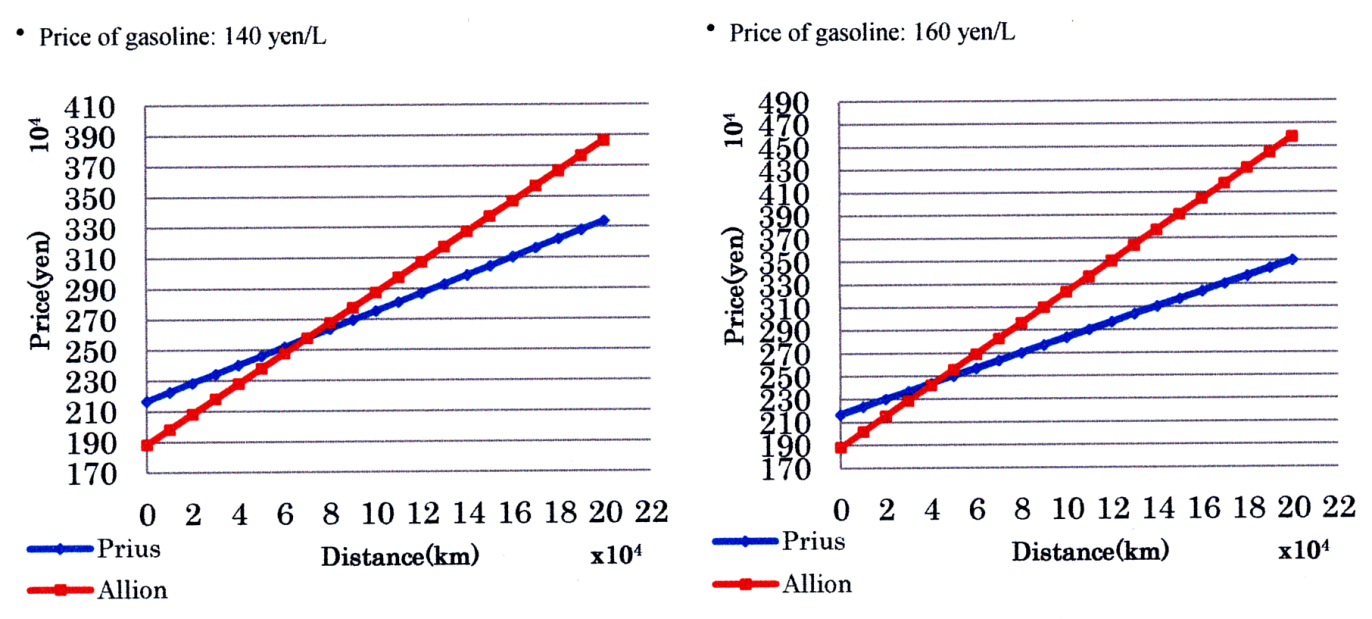 | Figure 6. Comparison of the actual fuel efficiency costs of Prius and Allion |
In the calculation based on the actual fuel efficiency, the price difference between Prius and Allion can be compensated for if the running distance is more than approximately 70,000 and 50,000 km when the price of gasoline is 140 and 160 yen/L, respectively. This suggests that the introduction of the hybrid automobile is effective, considering the lifetime running distance.As the fuel efficiency of Aqua in the 10/15 mode was 40.0 km/L, its actual fuel efficiency was calculated using the following formula: 40.0 × 0.622 = 24.9 km/L. As the fuel efficiency of Vitz in the 10/15 mode was 21.0 km/L, its actual fuel efficiency was calculated using the following formula: 21.0 × 0.76 = 16.0 km/L. Functions of the prices and distances were determined using these values, with the price of gasoline set at 140 and 160 yen, as shown in Figure 7. | Figure 7. Comparison of the actual fuel efficiency costs of Aqua and Vitz |
There was little difference between the calculated and actual fuel efficiency, as shown by the comparison between Prius and Allion. The price difference between Aqua and Vitz can be compensated for if the running distance is more than approximately 20,000 km when the price of gasoline is 140 and 160 yen/L. This suggests that the introduction of the hybrid automobile is effective, considering the lifetime running distance.To determine the future prevalence of Aqua, it is necessary to examine whether or not this compensation for the price difference applies to the relationship between hybrid and non-hybrid automobiles with a smaller engine capacity. The graph in Figure 8 shows a comparison of automobiles with an engine capacity of 1.3 L - one rank lower than that of Vitz.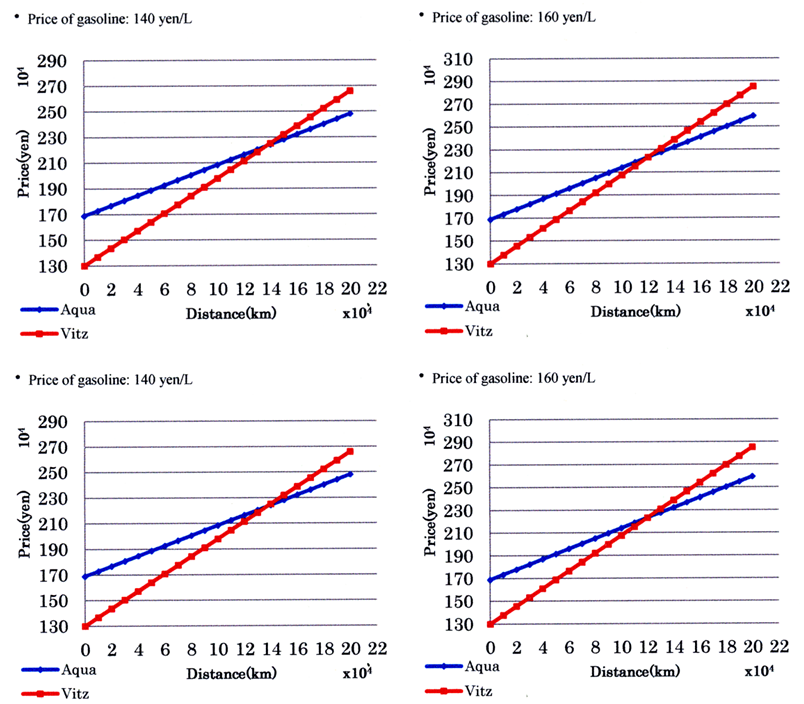 | Figure 8. Comparison of the costs of driving Aqua and Vitz |
The figure shows that the price difference between Vitz with an engine capacity of 1.3 L and a hybrid automobile of the same class cannot be compensated for even if the hybrid automobile drives a distance longer than the lifetime running distance.Comparisons involving other hybrid and non-hybrid automobiles, including Honda Fit with an engine capacity of 1.3 L and Nissan Note (1.2 L), were also conducted. Graphs in Figure 9 indicate the costs of driving Fit and Fit Hybrid.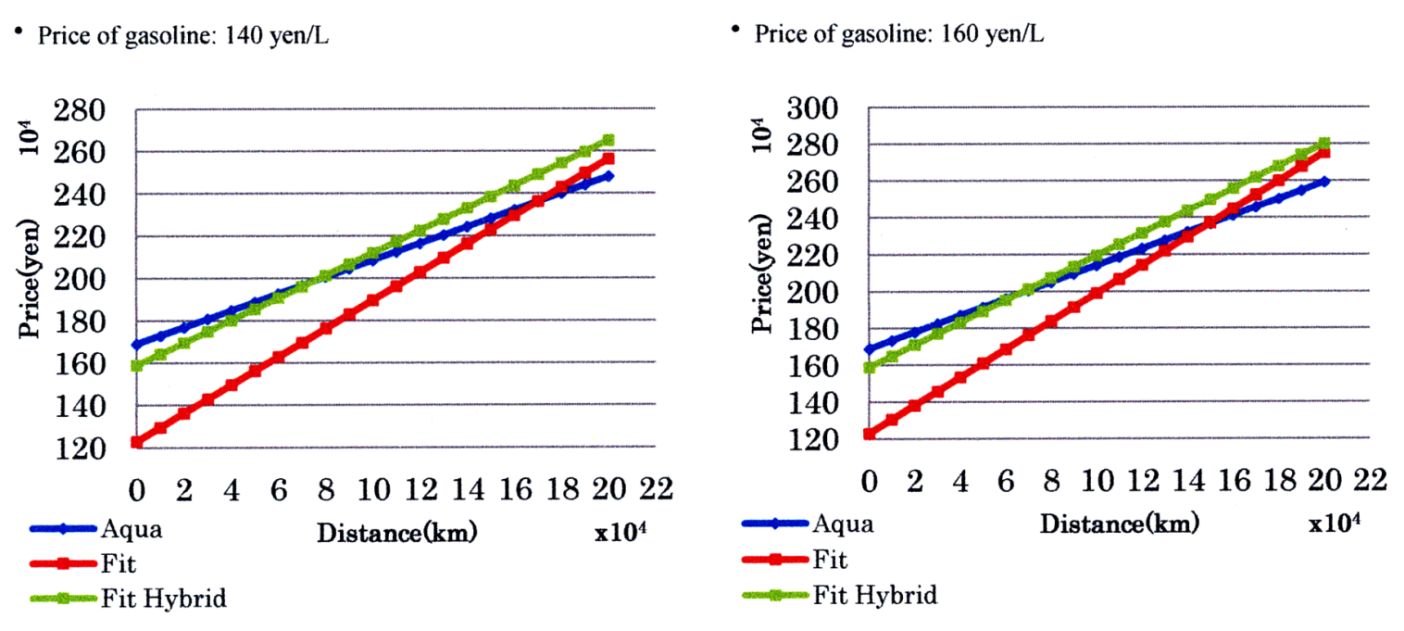 | Figure 9. Comparison of the costs of driving Aqua, Fit, and Fit Hybrid |
Graphs in Figure 10 indicate the costs of driving the Nissan Note lineup. The engine of Note DIG-S has adopted an improved technology.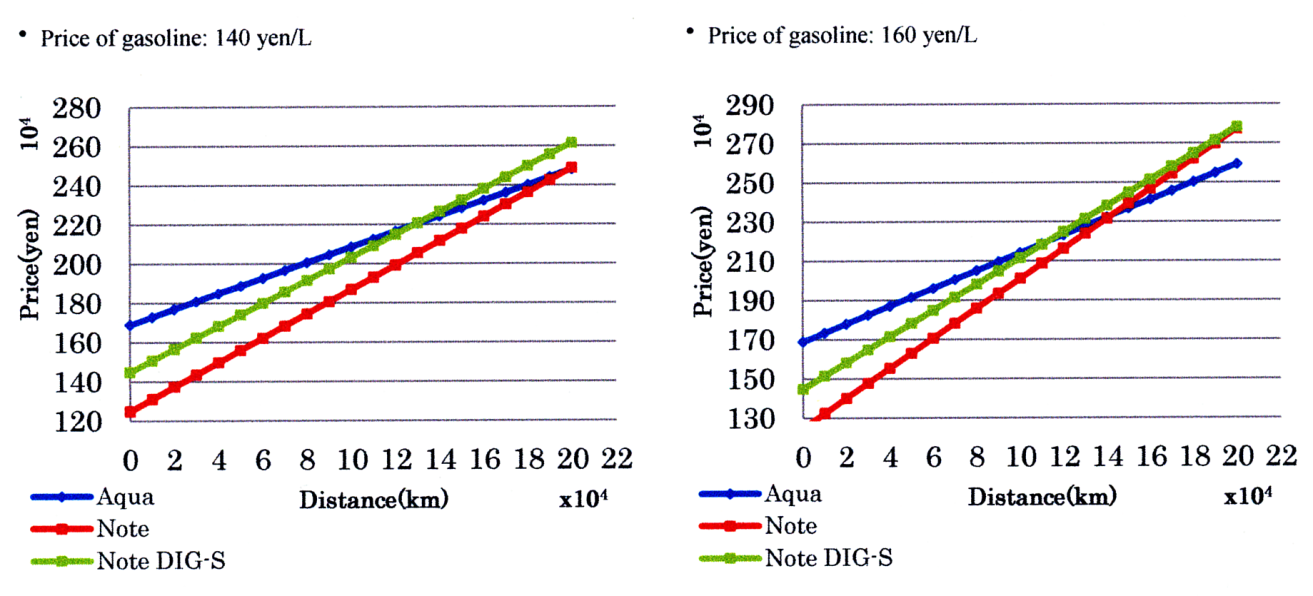 | Figure 10. Comparison of the costs of driving Aqua, Note, and Note DIG-S |
The results for the three automobiles are smaller than the lifetime running distance. The smaller the size of automobiles, the higher the rate of fuel efficiency improvement. Therefore, the adoption of the hybrid system in automobiles with an engine of 1.5 L or larger is effective.
4. Conclusions
The present study compared the performances of gasoline-fueled and hybrid automobiles throughout their lifetime. The results suggest that the adoption of the hybrid system in automobiles with an engine of 1.5 L or smaller, or compact cars, is ineffective.At present, hybrid automobiles are the first-choice next-generation cars. However, since there is no point in adopting the hybrid system to small automobiles, gasoline-fueled automobiles will continue to be widely used, and sales of gasoline-fueled automobiles will remain larger than those of hybrid ones. Nevertheless, if hybrid automobiles continue to increase at this rate, the number of hybrid automobiles in Japan will account for 22% of the total in 2020 [16]. As new models enter the market, the sales of hybrid automobiles are expected to increase.
References
| [1] | Ministry of Land, Infrastructure, Transport and Tourism, The amount of CO2 discharged in the transportation section, Japan, http://www.mlit.go.jp/sogoseisaku/environment/sosei_environment_tk_000007.html [Accessed 19 May, 2014]. |
| [2] | Toyota, For the repress of energy consumption and reduction of CO2 emission, http://www.toyota.co.jp/jp/environmental_rep/07/download/pdf/sr07_p10_18.pdf [Accessed 19 May, 2014]. |
| [3] | Honda, Fit: fuel consumption and running performance, http://www.honda.co.jp/Fit/webcatalog/performance/ [Accessed 19 May, 2014]. |
| [4] | Toyota, Grade and price, http://toyota.jp/crownathlete/004_p_001/concept/grade/grade1/ [Accessed 19 May, 2014]. |
| [5] | Toyota, Camry: Grade and price, http://toyota.jp/camry/?adid=ag065_ad492br_140317&padid=ag065_ad492br_140317&wapr=537b145a [Accessed 19 May, 2014]. |
| [6] | U.S. Energy Information Administration, Petroleum Reports, http://www.eia.gov/ [Accessed 19 May, 2014]. |
| [7] | Toyota, An outline of Camry,http://toyota.jp/camry/007_p_003/concept/concept/ [Accessed 20 May, 2014]. |
| [8] | Japan Automotive Products Association, Data (April, 2014), http://www.japa.gr.jp/data/pdf/1404.pdf [Accessed 20 May, 2014]. |
| [9] | Toyota, An outline of Prius: Grade and price, http://toyota.jp/prius/003_p_007/concept/concept/ [Accessed 20 May, 2014]. |
| [10] | Toyota, An outline of Allion: Grade and price, http://toyota.jp/allion/002_p_018/concept/concept/ [Accessed 20 May, 2014]. |
| [11] | Toyota, An outline of Aqua: Grade and price, http://toyota.jp/aqua/001_p_003/concept/concept/ [Accessed 20 May, 2014]. |
| [12] | Toyota, An outline of Vitz, Grade and Price, http://toyota.jp/vitz/003_p_010/concept/concept/ [Accessed 20 May, 2014]. |
| [13] | K. Furukawa and M. Yamashita, “Valuation of next-generation automobiles judging from commercially available automobiles,” World Environment, Vol. 4, pp. 80-92 (2014), and the references therein. |
| [14] | The Japan Automobile Manufacturers Association, Mean changes in the fuel efficiency of automobiles, http://www.jama.or.jp/eco/earth/index.html [Accessed 23 April, 2014]. |
| [15] | The Ministry of Land, Infrastructure, Transport and Tourism, The public hearing to the Japan Automobile Manufacturers Association, http://www.enecho.meti.go.jp/info/committee/kihonmondai/14th/14-4-3.pdf [Accessed 23 April, 2014]. |
| [16] | Nomura Research Institute, World eco-car: a sales forecast, http//en.responsejp.com/ [Accessed 21 May, 2014]. |











 Abstract
Abstract Reference
Reference Full-Text PDF
Full-Text PDF Full-text HTML
Full-text HTML
